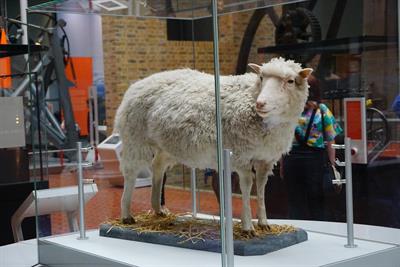
PUMPA - SMART LEARNING
எங்கள் ஆசிரியர்களுடன் 1-ஆன்-1 ஆலோசனை நேரத்தைப் பெறுங்கள். டாப்பர் ஆவதற்கு நாங்கள் பயிற்சி அளிப்போம்
Book Free DemoThe production of an exact copy of a cell, a part of the animal or the complete animal through asexual reproduction is called cloning.
Two animals that contain the same gene pool are called genetically identical. A clone is genetically identical to the parent organism.
Important!
The cloning of an animal was successfully first demonstrated by Ian Wilmut and his colleagues at the Roslin Institute in Edinburgh, Scotland.

Dolly - The cloned sheep
The first cloned mammal Dolly was born on \(5th\) July \(1996\). Dolly was cloned through the collection of a cell from the mammary gland of Finn Dorsett sheep. Simultaneously an egg was obtained from Scottish blackface ewe. Thus, two sheep involved in cloning Dolly were Finn Dorsett sheep and Scottish blackface ewe.
Cloning process:
- A cell is collected from the mammary gland of the Finn Dorsett sheep.
- An unfertilised egg cell was collected from the Scottish Blackface ewe, and the nucleus was removed from the egg.
- The nucleus of the mammary cell of the Finn Dorsett sheep was inserted into the empty egg cell of the Scottish Blackface ewe.
- The new egg cell produced was implanted into the uterus of Scottish Blackface ewe. The development of this egg normally produced the clone Dolly after \(148\)days.

The process of cloning of Dolly
Even though the Scottish Blackface ewe gave birth to Dolly, it was genetically identical to the Finn Dorsett sheep from which took the nucleus. Since the nucleus was removed from the egg of the Scottish blackface ewe, Dolly did not have any characteristics of Scottish blackface ewe.
Dolly was a healthy clone of the Finn Dorsett sheep and produced several offspring through normal sexual reproduction. Dolly died in February \(14\), \(2003\) due to lung disease. After Dolly, several attempts were made to produce cloned mammals. However, many of them die before birth or die soon after birth. The cloned animals were often found to be born with severe abnormalities.
Dolly was a healthy clone of the Finn Dorsett sheep and produced several offspring through normal sexual reproduction. Dolly died in February \(14\), \(2003\) due to lung disease. After Dolly, several attempts were made to produce cloned mammals. However, many of them die before birth or die soon after birth. The cloned animals were often found to be born with severe abnormalities.
Advantages of cloning:
- Production of exactly identical copies of animals.
- In domestic animals, superior milk yielding cows are cloned.
- Sheep that yields high and superior quality wool are cloned to produce sheep that give a high yield of superior quality as well.
Reference:
https://upload.wikimedia.org/wikipedia/commons/8/8c/Dolly_clone.svg
https://www.flickr.com/photos/bap824/42266644970